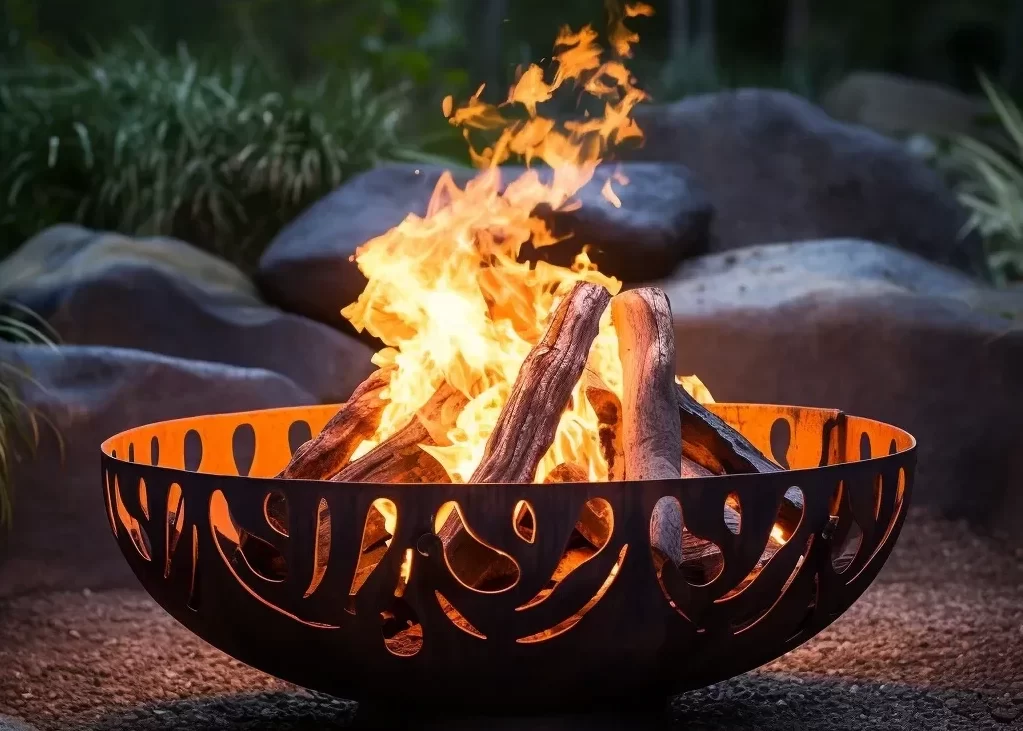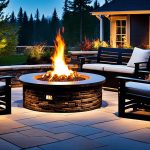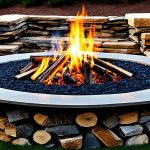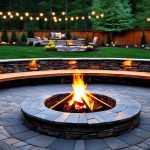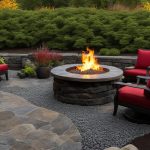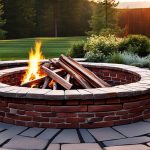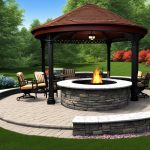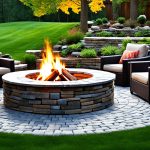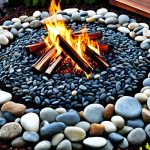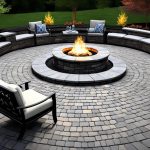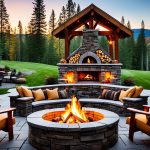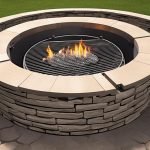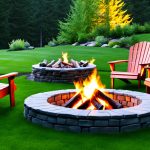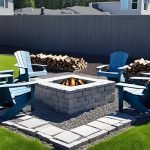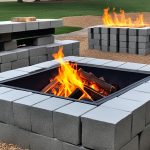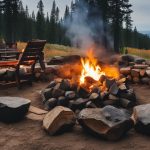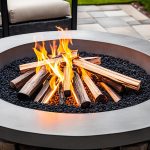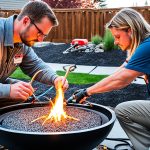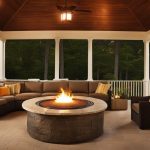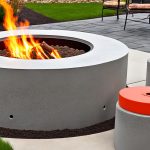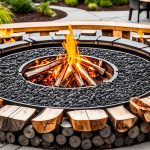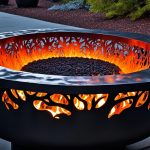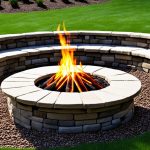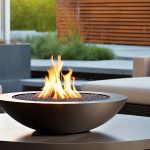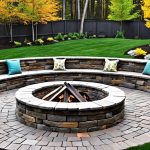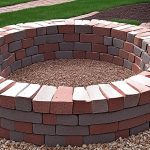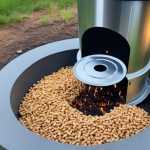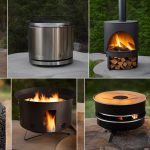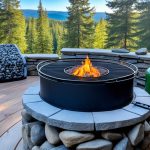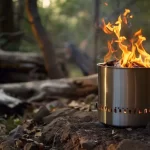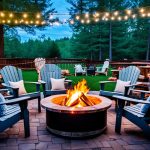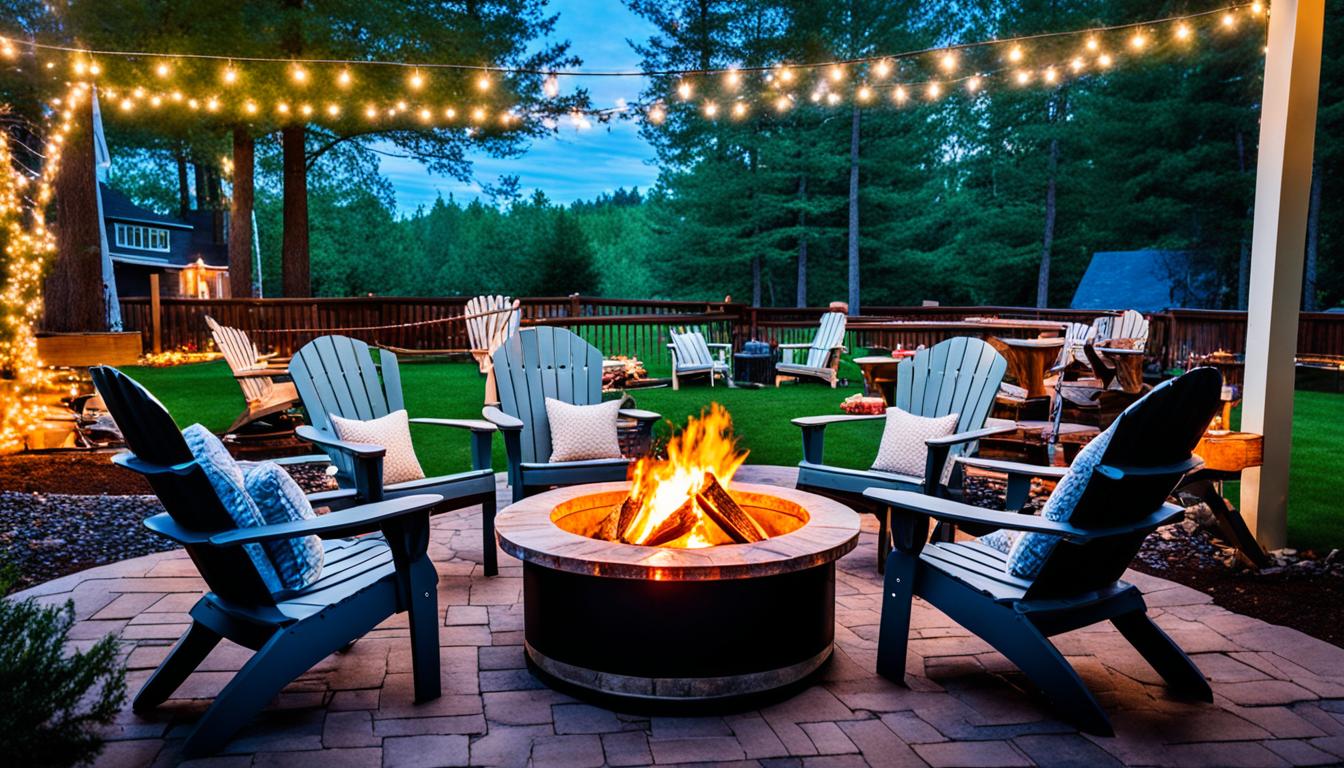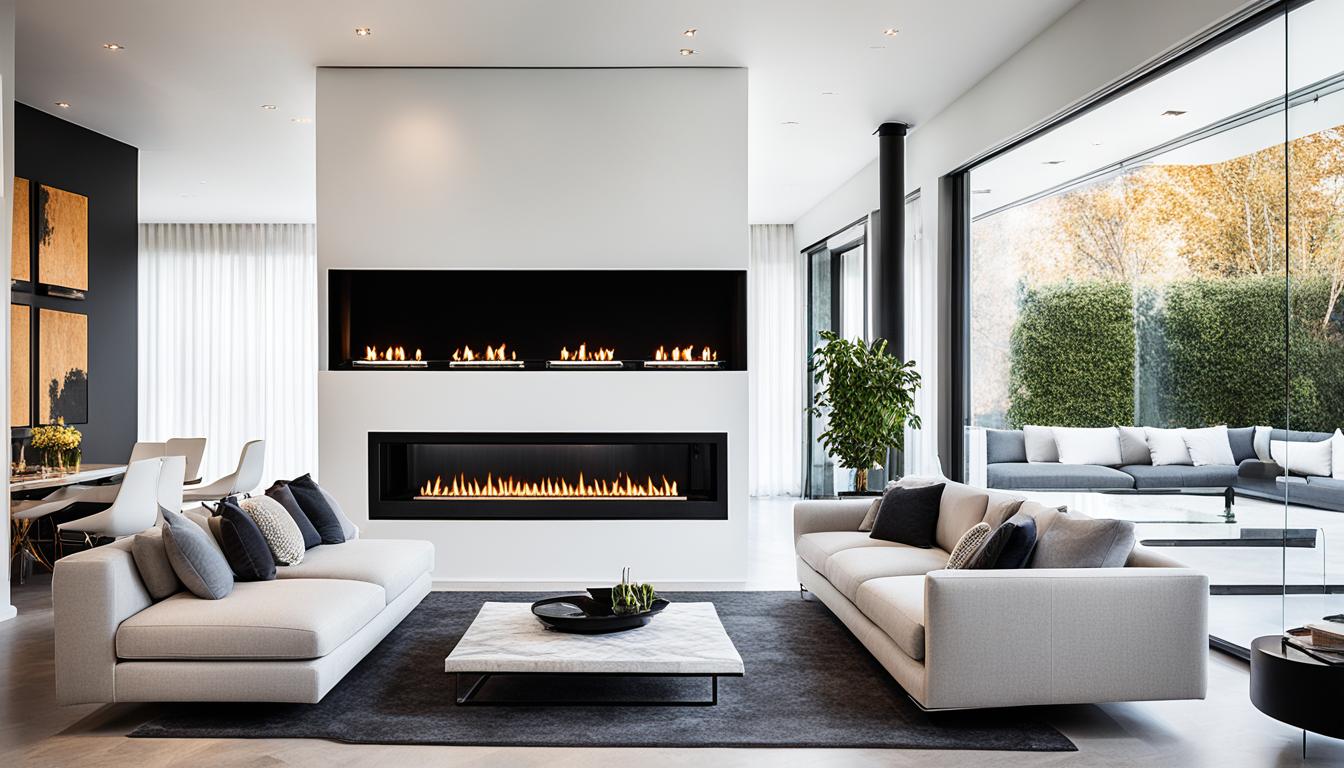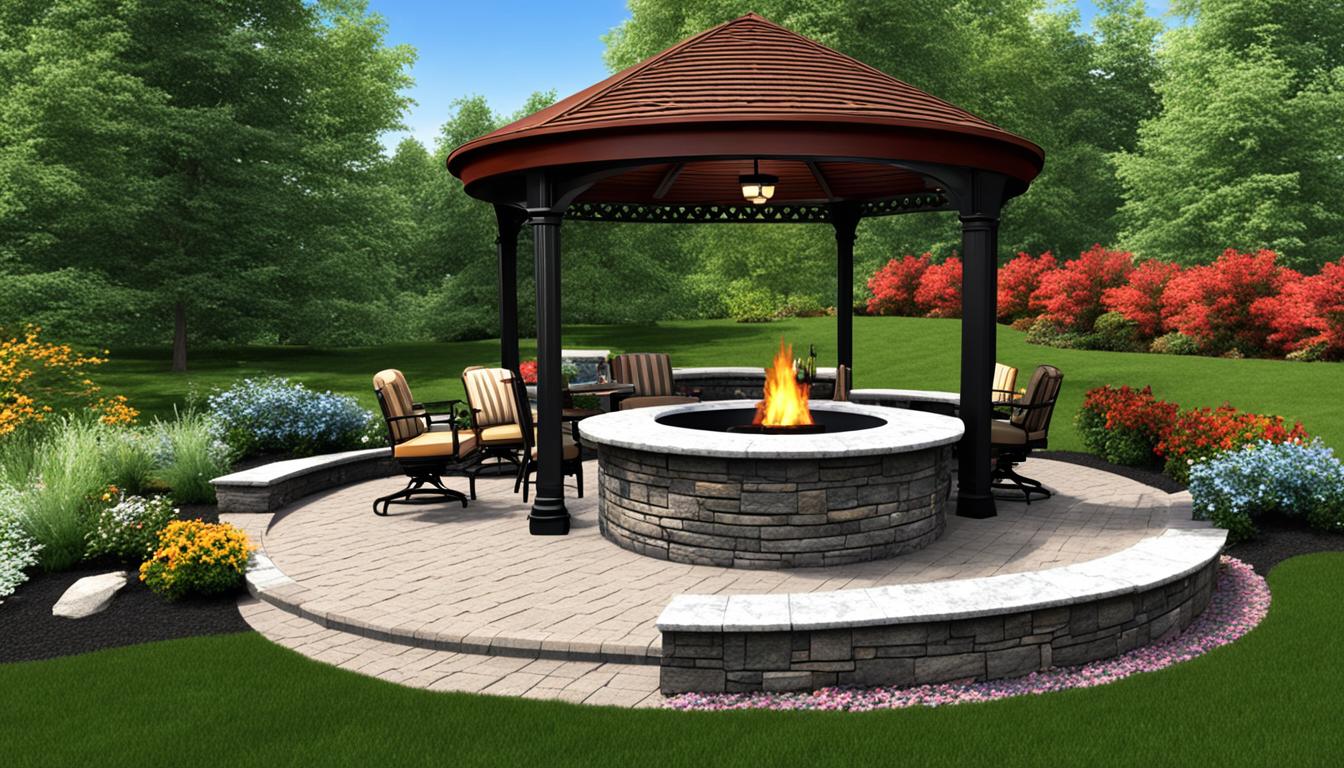Imagine cozy summer evenings spent gathered around a crackling fire in your own backyard. The warmth, the laughter, the joy of making lasting memories with family and friends. Building a fire pit in your backyard is easier than you might think, and it doesn’t have to break the bank.
Meet Sarah, a DIY enthusiast and lover of outdoor gatherings. She had always dreamed of having a fire pit in her backyard, but she thought it would be too expensive and complicated. One day, Sarah stumbled upon a guide on how to build a fire pit for under $80.
Fueled by excitement and armed with newfound knowledge, Sarah set out on her fire pit building adventure. With just a few weekends of hard work, Sarah transformed her backyard into a cozy oasis.
Key Takeaways:
- Building a fire pit in your backyard is an affordable way to create a cozy gathering spot.
- You can build a fire pit for under $80 with the right materials and techniques.
- A DIY fire pit project can be a fun and rewarding experience for anyone.
- Finding the perfect location and gathering the necessary materials are the first steps in the process.
- Safety should always be a top priority when using a fire pit.
Choosing the Perfect Location for Your Fire Pit
Before you begin constructing your backyard fire pit, it’s essential to select the ideal location. Choosing the right spot will ensure a safe and enjoyable experience for you and your guests. Consider the following factors when determining the perfect location for your outdoor fire pit:
- Safety: Find an area in your backyard that is a safe distance away from any structures, trees, or flammable materials. This will minimize the risk of accidental fires spreading.
- Wind direction: Take note of the prevailing wind direction in your area. Position your fire pit so that the smoke will not blow towards your home or outdoor seating areas.
- Aesthetics: Look for a location that complements your backyard’s overall design and layout. Your fire pit can serve as a focal point, so choose a spot that enhances the overall ambiance of your outdoor space.
- Accessibility: Consider how easily you and your guests can access the fire pit area. You’ll want a spot that is convenient and comfortable for everyone to gather around.
- Level ground: Ensure that the ground where you plan to build your fire pit is level. This will provide stability and prevent any potential accidents.
By taking these factors into account, you’ll be able to select the perfect location for your backyard fire pit. Remember to check local fire regulations and obtain any necessary permits before beginning construction.
“Choosing the right location is crucial when building a fire pit. It impacts safety, comfort, and aesthetics. Take your time to find the perfect spot in your backyard.”
With the location decided, it’s time to gather the materials needed for your DIY fire pit project. In the next section, we’ll explore the essential materials and provide budget-friendly options to get you started on creating your backyard oasis.
Gathering Materials for Your DIY Fire Pit
Building your own fire pit is an exciting project that allows you to create a cozy gathering spot right in your own backyard. To get started, you’ll need to gather the necessary materials. Here, we’ll outline the key components needed for fire pit construction, while keeping your budget in mind. Let’s dive in!
Fire Pit Materials Checklist
Before you begin, make sure you have the following materials on hand:
- Fire Pit Ring or Insert: This is the central component of your fire pit. It provides a safe and secure area for building your fire. Choose a durable fire pit ring in a size that fits your desired dimensions.
- Bricks or Pavers: These will be used to create the base and wall of your fire pit. Opt for heat-resistant bricks or pavers that can withstand high temperatures.
- Gravel: A layer of gravel at the bottom of your fire pit will aid in drainage and prevent the fire from reaching the underlying soil.
- Sand: Use sand to create a level surface for laying the bricks or pavers. It also helps with stability and leveling.
- Landscape Fabric: This fabric acts as a barrier between the fire pit and the ground, preventing weeds from growing through the gravel.
- Fire Pit Tools and Accessories: Essential tools include a shovel for digging, a level for ensuring even placement, and steel tongs for safely handling firewood.
Sourcing Fire Pit Materials on a Budget
While it’s tempting to splurge on high-end materials, you can still achieve a beautiful and functional fire pit on a budget. Here are some tips for sourcing affordable materials:
- Visit local home improvement stores and compare prices to find the best deals.
- Check online marketplaces and classified ads for used fire pit rings or bricks at discounted prices.
- Consider alternative materials such as concrete blocks or natural stones, which can often be more budget-friendly.
- Inquire with friends or neighbors who may have leftover materials from their own projects.
Inexpensive doesn’t mean low-quality. With some creativity and resourcefulness, you can find budget-friendly materials that are durable and visually appealing.
Now that you have your materials ready, you’re one step closer to building your own fire pit. In the next section, we’ll explore design ideas to help you create a stunning focal point in your backyard.
| Material | Approximate Cost |
|---|---|
| Fire Pit Ring or Insert | $30 – $60 |
| Bricks or Pavers | $1 – $3 per piece |
| Gravel | $15 – $25 per bag |
| Sand | $5 – $10 per bag |
| Landscape Fabric | $10 – $20 per roll |
| Fire Pit Tools and Accessories | Varies |
Design Ideas for Your Fire Pit
When it comes to designing your fire pit, the options are endless. Whether you’re looking for a rustic, traditional feel or a modern, sleek look, there are design ideas to suit every backyard. Let’s explore some creative and functional designs that will transform your outdoor space into a cozy gathering spot.
1. Natural Stone:
Utilizing natural stone in your fire pit design adds a timeless and picturesque element to your backyard. Choose from a variety of shapes and colors to create a unique focal point. The irregular edges and textures of natural stone provide a rustic charm that complements any outdoor setting.
2. Built-In Seating:
Enhance the functionality of your fire pit by incorporating built-in seating. This not only provides a comfortable and convenient place to gather with family and friends but also adds a stylish touch to your outdoor space. Consider using stone or concrete materials for durability and easy maintenance.
3. Fire Pit Table:
For a multi-functional fire pit design, consider a fire pit table. This innovative option combines the warmth and ambiance of a fire pit with the practicality of a table. Perfect for outdoor dining or entertaining, fire pit tables come in various styles and sizes to suit your needs.
4. Modern Minimalism:
If you prefer a clean and contemporary aesthetic, opt for a modern fire pit design. Sleek lines, minimalist materials, and geometric shapes create a sophisticated and stylish look. Choose materials like stainless steel or concrete to achieve a sleek and polished finish.
“Design is not just what it looks like, it’s how it works.” – Steve Jobs
5. Fire Pit with Water Feature:
Elevate the ambiance of your fire pit area by incorporating a water feature. The combination of the soothing sound of flowing water and the warm glow of the fire creates a tranquil and captivating outdoor oasis. Get creative with different water feature designs such as a fountain or a small pond.
6. Fire Pit Patio:
Take your fire pit to the next level by creating a dedicated fire pit patio area. Use pavers or stone tiles to define the space and add a sense of organization to your backyard. Additionally, consider adding outdoor lighting or hanging string lights to create a cozy and inviting atmosphere.
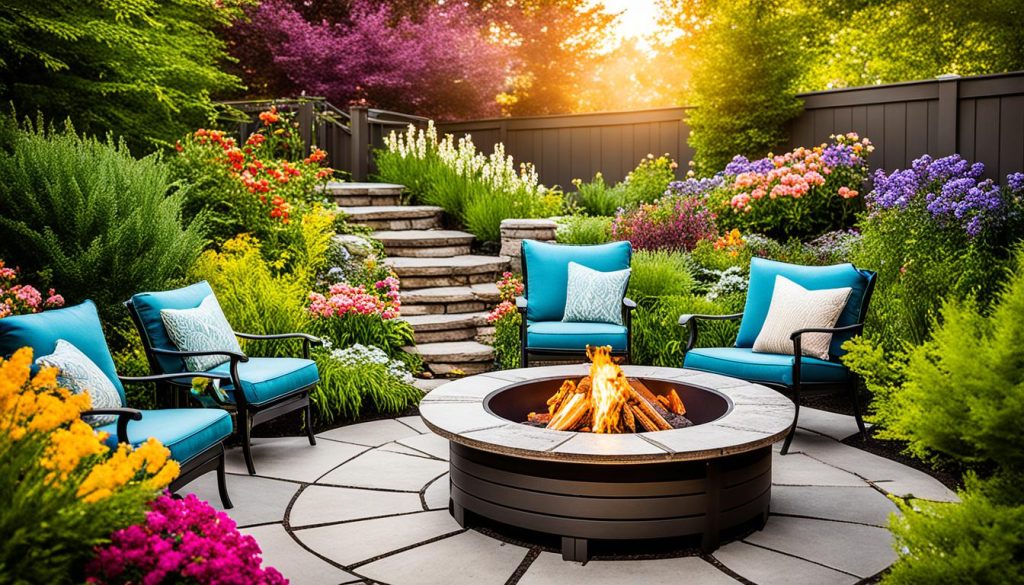
These design ideas are just the beginning. Let your imagination run wild and personalize your fire pit to reflect your unique style and preferences. Remember to prioritize safety by keeping a safe distance between your fire pit and any flammable materials, and always follow local fire regulations.
Preparing the Fire Pit Area
Before embarking on the construction of your fire pit, it is crucial to adequately prepare the designated area. By taking the necessary steps to ensure a safe environment, you can enjoy your fire pit with peace of mind. Here’s a guide to help you prepare your fire pit area:
- Clear the area: Start by removing any debris, vegetation, or flammable materials from the designated fire pit area. This includes dry leaves, branches, and grass. Clearing the area will help minimize the risk of accidental fires spreading beyond the fire pit.
- Check for underground utilities: Before digging, it is essential to identify and mark any underground utilities, such as gas lines or electrical cables. Contact your local utility companies to request assistance with utility locating to prevent any damage or accidents during the construction process.
- Choose a safe distance: Consider the proximity to structures, trees, and other flammable materials when determining the ideal location for your fire pit. The fire pit should be positioned at least 10-20 feet away from any combustible surfaces or overhanging branches.
- Level the ground: Ensure that the ground where the fire pit will be placed is level. This will help prevent any wobbling or instability once the fire pit is constructed.
- Create a safety zone: Designate a non-combustible area around the fire pit, such as a gravel or concrete pad, to act as a safety buffer. This zone should extend at least three feet from the fire pit to help contain any sparks or embers.
- Consider wind direction: Take into account the prevailing wind direction in your backyard when positioning your fire pit. Keeping the fire pit upwind from your seating area will prevent smoke and sparks from blowing directly towards you and your guests.
Following these preparation steps will play a crucial role in ensuring the safety of your fire pit area. Now that you have prepared the site, you’re ready to move on to the next stage of constructing your fire pit.

Marking and Digging the Fire Pit Area
Once you have chosen the perfect location for your fire pit, it’s time to mark the dimensions and start digging. This step is essential for ensuring that your fire pit is structurally sound and fits seamlessly into your backyard. Follow these tips to accurately mark the area and make the digging process easier and more efficient.
1. Measure and Mark
To begin, measure the diameter of your desired fire pit. Use a tape measure to mark the center point of the pit location. Then, tie a string around a stake and place it at the marked center point. Pull the string tight and walk in a circle, marking the circumference of the fire pit with spray paint or flour.
2. Determine the Depth
Consider the type of fire pit you want to build and the recommended depth for that specific design. In general, a depth of 12-18 inches is suitable for most fire pits. Mark the desired depth by tying another string around the stake at the center and adjusting it to the desired depth. This will help you dig to the correct depth consistently.
3. Digging Tips
Now that you have marked the area and determined the depth, it’s time to start digging. Use a shovel or a post hole digger to remove the soil within the marked circle. To make the digging process easier:
- Start by digging a small trench along the marked circumference. This will provide a clear boundary for the fire pit walls.
- Remove the soil gradually, working your way toward the center. This prevents the edges from collapsing and ensures a stable base.
- Check the depth periodically using a tape measure or a stake with the desired depth marked on it.
- Dispose of the excavated soil or repurpose it for other areas of your yard if suitable.
Remember to take breaks, drink plenty of water, and pace yourself while digging. It’s also a good idea to enlist the help of a friend or family member to make the task more manageable.
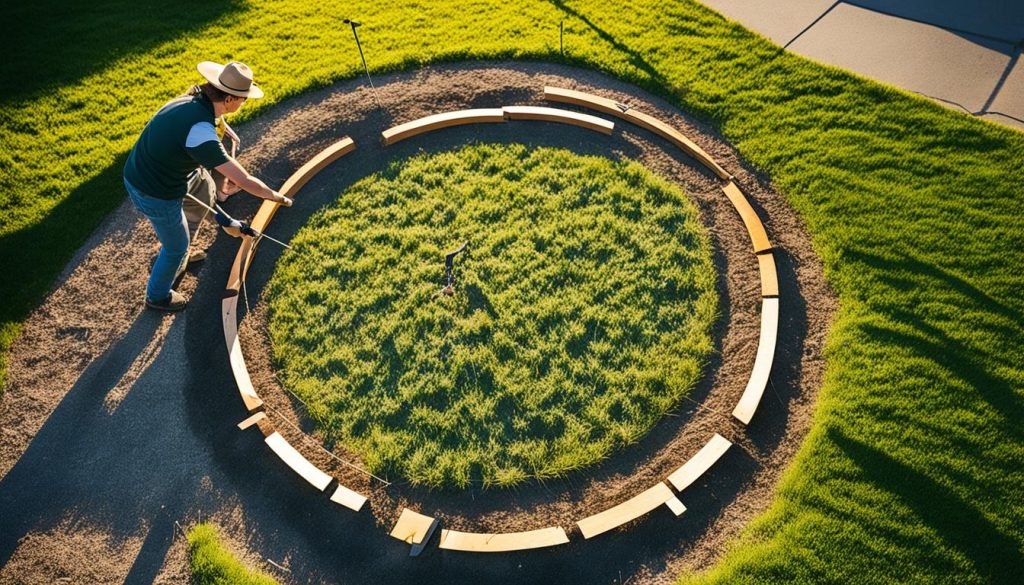
Once the hole is dug to the desired depth, you’re ready to move on to the next step in building your fire pit. In the upcoming section, we’ll guide you through the process of building the base and wall of your fire pit, using the materials you have gathered.
Building the Base and Wall of Your Fire Pit
In order to create a sturdy and attractive fire pit, it’s essential to carefully construct the base and wall. This section will guide you through the step-by-step process, highlighting different materials and techniques for a successful DIY project.
First, let’s start with the base. The foundation of your fire pit is crucial for stability and longevity. One popular option is using concrete blocks, which are affordable and widely available. Dig a shallow trench to create a level surface, ensuring proper drainage. Then, lay the blocks in a circular shape, using a level to make sure they are aligned.
If you prefer a more rustic look, natural stone can be an excellent choice. Stacked stone or fieldstone offer a unique and beautiful appearance, blending seamlessly with your outdoor space. However, keep in mind that stone requires careful planning and precise placement to ensure stability.
Tip: Consider using a layer of sand or gravel between the base and the fire pit floor. This will help with drainage and prevent shifting of the base over time.
Once the base is complete, it’s time to focus on the wall. This not only adds height to the fire pit but also provides a barrier for safety. Again, concrete blocks or natural stone can be used, depending on your preference.
Concrete Block Wall
If you choose concrete blocks for the wall, start by stacking them on top of the base. Apply construction adhesive between each block to ensure a secure bond. As you go, use a level to check for straightness. Depending on the desired height of your fire pit, you may need multiple layers of blocks. Make sure to stagger the seams for added stability.
Natural Stone Wall
To build a natural stone wall, select stones of varying sizes and shapes. Begin by positioning larger stones as the base layer, ensuring they are level and stable. Add smaller stones on top, filling in gaps with mortar or stone adhesive. Alternate the sizes and angles of the stones to create a visually appealing pattern.
Whichever material you choose, take your time to carefully construct the wall, ensuring each piece is secure and level. This will provide a solid foundation for your fire pit.
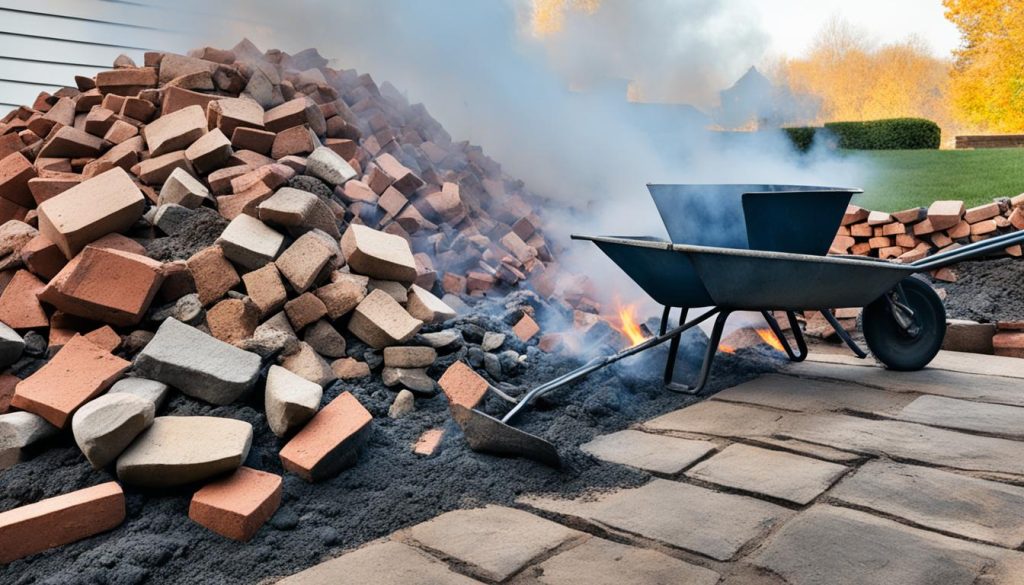
| Material | Pros | Cons |
|---|---|---|
| Concrete Blocks | – Affordable | – Can have a less natural appearance |
| Natural Stone | – Beautiful and rustic | – Requires careful planning |
| Brick | – Classic look | – Can be more expensive |
Adding a Gravel Bed and Fireproof Layer
When it comes to fire pit construction, safety should be your top priority. Adding a gravel bed and fireproof layer is essential to protect your backyard and prevent any accidents. Let’s take a closer look at how to create a safe foundation for your fire pit.
1. Creating a Gravel Bed
Start by excavating the area where your fire pit will be located. Dig a hole approximately 12 inches deep and wider than the dimensions of your fire pit. Once the hole is dug, spread a layer of gravel at the bottom to create a stable and heat-resistant base.
Gravel not only helps with drainage, but it also acts as a barrier between the fire pit and the ground. This prevents the heat from reaching the underlying soil and minimizes the risk of fire damage to your yard.
2. Applying a Fireproof Layer
After creating the gravel bed, it’s important to provide an additional layer of protection. For this, you’ll need a fireproof material such as fire bricks or pavers.
Arrange the fire bricks or pavers around the inner circumference of your fire pit, stacking them vertically to create a wall. This layer acts as insulation, reducing the amount of heat transferred to the surrounding area.
It is important to ensure that the fireproof layer is securely in place and that there are no gaps between the bricks or pavers. This will prevent any embers or sparks from escaping the fire pit and causing unintentional fires.
3. Maintaining a Safe Distance
Lastly, remember to keep a safe distance between your fire pit and any flammable materials or structures. It is recommended to have at least a 10-foot clearance from any vegetation, fences, or buildings.
Regularly inspect and clean the area around your fire pit to remove any debris or flammable materials that may have accumulated. This will minimize the risk of accidental fires and increase the overall safety of your outdoor space.
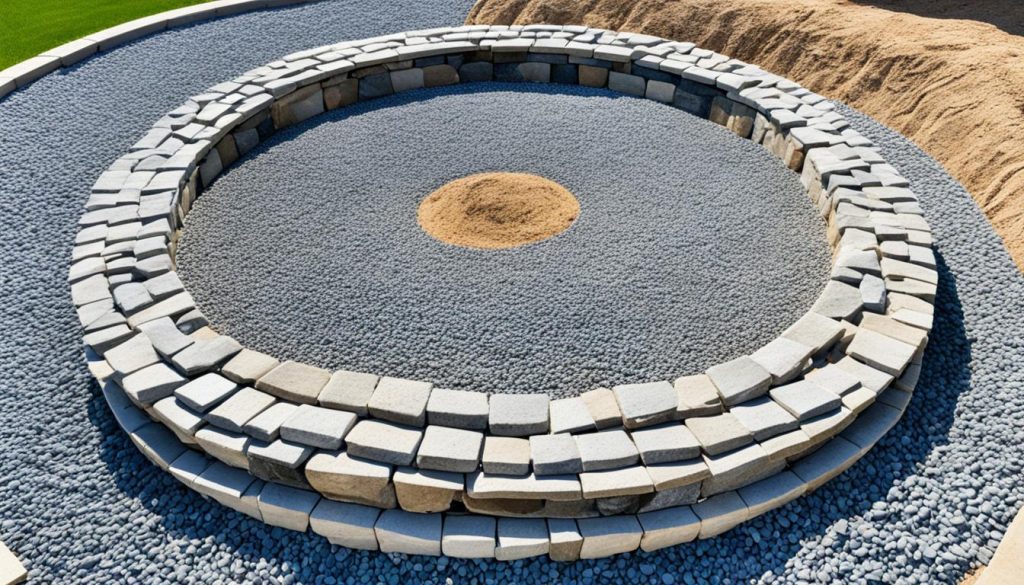
Incorporating a gravel bed and fireproof layer into your fire pit construction is an important step in ensuring the safety of your backyard. By following these guidelines, you can have peace of mind knowing that you’ve taken the necessary precautions to protect your property and loved ones.
Finishing Touches and Decorative Elements
Once you have built your fire pit, it’s time to add the finishing touches and decorative elements that will truly make it shine in your backyard. These simple additions can enhance the ambiance of your outdoor space and create a cozy atmosphere for gatherings with family and friends.
Pick the Right Seating
Choose comfortable and durable seating options that complement the aesthetic of your fire pit. Whether it’s cozy outdoor chairs, patio benches, or even rustic logs, make sure there is enough seating for everyone to gather around the fire.
Lighting the Way
Consider incorporating lighting elements around your fire pit area for both practicality and aesthetics. Add string lights, lanterns, or solar-powered pathway lights to create a warm and inviting glow in the evenings.
Outdoor Rugs and Pillows
Bring comfort and style to your fire pit area with the addition of outdoor rugs and pillows. Choose weather-resistant materials to ensure they can withstand the elements and add a pop of color or pattern to your outdoor space.
Tabletop Decor
Add a tabletop to your fire pit area to create a functional space for drinks and snacks. Decorate the table with candles, planters, or even a small centerpiece to add a touch of elegance to your outdoor gathering spot.
Fire Pit Accessories
Don’t forget to accessorize your fire pit itself! Consider adding a fire pit cover to protect it when not in use, a fire pit tool set for easy maintenance, or a spark screen to ensure safety during use.
“The right finishing touches can transform your fire pit from a simple construction to a stunning centerpiece in your backyard.”
With these finishing touches and decorative elements, your fire pit will become a focal point of your backyard, providing warmth, ambiance, and endless opportunities for outdoor enjoyment.
Fire Pit Safety Measures
Safety should always be a top priority when using a fire pit. Follow these essential safety measures and precautions to ensure a safe and enjoyable experience.
1. Choose a suitable location
When constructing your fire pit, select a location that is away from any flammable materials, structures, or low-hanging tree branches. Keep a safe distance from your home and other outdoor furniture to prevent accidental fires.
2. Use the right materials
Ensure that your fire pit is constructed using fire-resistant materials such as bricks, pavers, or metal. Avoid using materials that can easily catch fire or release toxic fumes.
3. Maintain a safe distance
When using the fire pit, keep a safe distance from the flames to avoid burns or injuries. Establish a designated seating area around the fire pit and set clear boundaries to prevent accidental contact with the fire.
4. Provide proper ventilation
Ensure that the fire pit area has proper ventilation to prevent the buildup of smoke and carbon monoxide. Place the fire pit in an open area where the smoke can disperse easily.
5. Keep a fire extinguisher nearby
Always have a fire extinguisher or a bucket of sand or water nearby in case of emergencies. Never leave the fire pit unattended and be prepared to extinguish the fire if necessary.
6. Practice safe fire management
Avoid using flammable liquids such as gasoline or lighter fluid to ignite the fire. Instead, use fire starters or kindling to start the fire safely. Once the fire is lit, do not overload the pit with excessive amounts of wood or other combustible materials.
7. Supervise children and pets
Keep a close eye on children and pets when the fire pit is in use. Establish clear rules and boundaries to ensure their safety and prevent accidents.
8. Properly extinguish the fire
Before leaving the fire pit unattended or going to sleep, make sure to fully extinguish the fire. Use water or sand to put out the flames and carefully monitor the area for any leftover sparks or embers.
| Fire Pit Safety Checklist | ✔️ |
|---|---|
| Choose a suitable location | ✔️ |
| Use fire-resistant materials | ✔️ |
| Maintain a safe distance | ✔️ |
| Provide proper ventilation | ✔️ |
| Keep a fire extinguisher nearby | ✔️ |
| Practice safe fire management | ✔️ |
| Supervise children and pets | ✔️ |
| Properly extinguish the fire | ✔️ |
Following these fire pit safety measures will ensure that you and your loved ones can enjoy the warmth and ambiance of your fire pit without any unnecessary risks. Remember to always prioritize safety when using your fire pit.
Maintenance and Care for Your Fire Pit
Proper maintenance and care are essential to ensure the longevity and optimal performance of your outdoor fire pit. By implementing a regular maintenance routine, you can keep your fire pit clean, safe, and functioning efficiently for years to come. Here are some essential tips for fire pit maintenance and care:
1. Regular Cleaning
To prevent the buildup of ash, debris, and soot, it’s important to clean your fire pit regularly. Use a brush or broom to sweep out any loose material, and then wipe down the surfaces with a damp cloth. For stubborn stains, you can use a mild detergent or a mixture of water and vinegar. Make sure to rinse thoroughly and allow the fire pit to dry completely before using it again.
2. Checking for Damage
Inspect your fire pit regularly for any signs of damage or wear. Check for cracks, rust, loose components, or any other issues that may affect its functionality. It’s important to address these problems early to prevent further damage and ensure the safety of your fire pit.
3. Protecting from the Elements
Outdoor fire pits are exposed to various weather conditions, which can affect their durability. If possible, cover your fire pit when not in use to protect it from rain, snow, and excessive sunlight. Additionally, consider investing in a fire pit cover specifically designed to shield it from the elements.
| Seasonal Maintenance | Maintenance Tasks |
|---|---|
| Spring | Inspect for winter damage Replace or repair any damaged parts Clean thoroughly after the winter season |
| Summer | Remove any debris Check for insect nests Ensure proper ventilation |
| Fall | Clear leaves and other debris Check for rust or corrosion Apply a protective sealant (if applicable) |
| Winter | Keep fire pit covered when not in use Remove snow and ice Avoid using corrosive de-icing agents |
4. Maintaining Fire Safety
Fire safety is paramount when using a fire pit. Always follow safety guidelines and local regulations to ensure a safe environment. Keep a fire extinguisher nearby, avoid placing flammable materials near the fire pit, and never leave the fire unattended. Regularly check that the fire pit is in good working condition and that it meets all necessary safety standards.
“Proper maintenance and care are essential to ensure the longevity and optimal performance of your outdoor fire pit.”
By incorporating these maintenance and care practices into your routine, you can enjoy a clean, safe, and functional fire pit for many memorable outdoor gatherings. Remember, regular upkeep and attention to safety will help preserve your fire pit and extend its lifespan.
Conclusion
Building a fire pit in your backyard is a simple and affordable project that can transform your outdoor space into a cozy gathering spot. With our step-by-step guide and helpful tips, you can easily construct a fire pit for under $80. Whether you’re looking to roast marshmallows, enjoy a warm fire on a chilly evening, or create a focal point for entertaining, a DIY fire pit is the perfect addition to your backyard.
By following the fire pit construction process outlined in this article, you’ll be able to choose the perfect location, gather the necessary materials, and create a sturdy and attractive fire pit. Remember to consider safety measures such as adding a gravel bed and fireproof layer, and always follow proper maintenance and care instructions to ensure longevity.
Don’t wait any longer to create your own backyard fire pit. Start your DIY fire pit project today and enjoy memorable evenings around the fire with family and friends. With a little time, effort, and creativity, you’ll have a beautiful fire pit that will enhance your outdoor living space for years to come.

